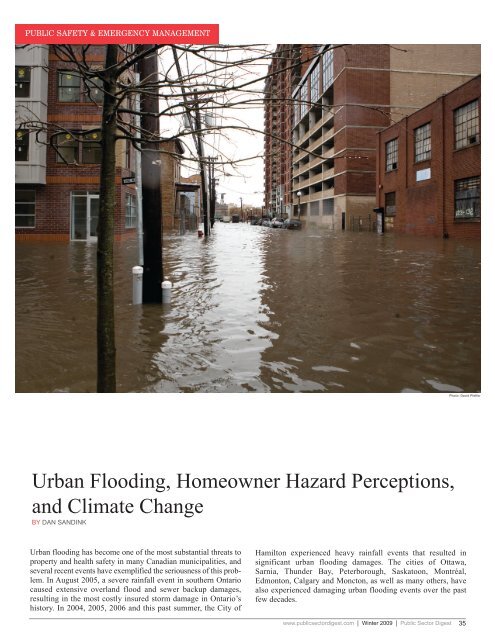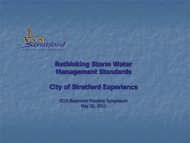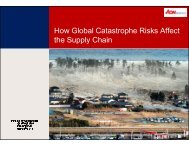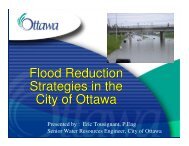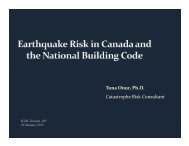Urban Flooding, Homeowner Hazard Perceptions, and Climate ...
Urban Flooding, Homeowner Hazard Perceptions, and Climate ...
Urban Flooding, Homeowner Hazard Perceptions, and Climate ...
You also want an ePaper? Increase the reach of your titles
YUMPU automatically turns print PDFs into web optimized ePapers that Google loves.
PUBLIC SAFETY & EMERGENCY MANAGEMENT<br />
Photo: David Pfeffer<br />
<strong>Urban</strong> <strong>Flooding</strong>, <strong>Homeowner</strong> <strong>Hazard</strong> <strong>Perceptions</strong>,<br />
<strong>and</strong> <strong>Climate</strong> Change<br />
BY DAN SANDINK<br />
<strong>Urban</strong> flooding has become one of the most substantial threats to<br />
property <strong>and</strong> health safety in many Canadian municipalities, <strong>and</strong><br />
several recent events have exemplified the seriousness of this problem.<br />
In August 2005, a severe rainfall event in southern Ontario<br />
caused extensive overl<strong>and</strong> flood <strong>and</strong> sewer backup damages,<br />
resulting in the most costly insured storm damage in Ontario’s<br />
history. In 2004, 2005, 2006 <strong>and</strong> this past summer, the City of<br />
Hamilton experienced heavy rainfall events that resulted in<br />
significant urban flooding damages. The cities of Ottawa,<br />
Sarnia, Thunder Bay, Peterborough, Saskatoon, Montréal,<br />
Edmonton, Calgary <strong>and</strong> Moncton, as well as many others, have<br />
also experienced damaging urban flooding events over the past<br />
few decades.<br />
www.publicsectordigest.com Winter 2009 Public Sector Digest 35
“”<br />
However, the barrier of low public awareness will have to be<br />
overcome to effectively engage homeowners in urban flood risk<br />
reduction.<br />
Insured damages from the southern Ontario storm of 2005 were<br />
estimated at $500 million, second only to the 1998 Ontario-Québec<br />
Ice Storm as the most expensive catastrophe in the Canadian insurance<br />
industry’s history. Of the $500 million total, approximately<br />
$247 million was directly attributed to sewer backup damages.<br />
<strong>Flooding</strong> events in 2005 in southern Alberta resulted in $300 million<br />
in insured damages, $144 million of which was attributed to<br />
sewer backup. 1<br />
Frustrations associated with urban flooding for homeowners are<br />
compounded by the fact that damages caused by infiltration <strong>and</strong><br />
overl<strong>and</strong> flooding are uninsurable. While sewer backup coverage<br />
is available, it must often be specifically requested by<br />
homeowners <strong>and</strong> provided as an optional endorsement at an<br />
additional cost. In some cities, homeowners may find it difficult to<br />
retain coverage for sewer backup damages, as insurers are<br />
discovering that costs associated with this peril are unsustainable,<br />
<strong>and</strong> are limiting or withdrawing coverage.<br />
<strong>Climate</strong> change will increase the frequency <strong>and</strong> intensity of heavy<br />
rainfall events, thereby increasing the risk of urban flooding. While<br />
addressing infrastructure issues is a necessary component of reducing<br />
urban flood risk, individual homeowners can have a<br />
significant role in reducing risk through protecting their own<br />
homes <strong>and</strong> reducing their contributions of stormwater to municipal<br />
sanitary sewers <strong>and</strong> stormwater management systems. However,<br />
the barrier of low public awareness will have to be overcome<br />
to effectively engage homeowners in urban flood risk reduction.<br />
Some cities have been working to improve homeowner knowledge<br />
<strong>and</strong> risk-reducing behaviour through education <strong>and</strong> financial<br />
assistance programs.<br />
I.<br />
URBAN AND BASEMENT FLOODING<br />
<strong>Urban</strong> flooding occurs in urban areas, where the impacts of<br />
extreme rainfall <strong>and</strong> snowmelt are exacerbated by high<br />
concentrations of impervious surfaces, infrastructure, buildings,<br />
property <strong>and</strong> people. <strong>Urban</strong> flooding can have serious implications<br />
for both buildings <strong>and</strong> infrastructure, as extreme flows of water<br />
during heavy rainfall events can damage both overl<strong>and</strong> <strong>and</strong><br />
underground stormwater management infrastructure. Basement<br />
flooding is a specific impact of urban flood events, <strong>and</strong> is largely<br />
caused by overl<strong>and</strong> flows, sewer backup <strong>and</strong> infiltration flooding.<br />
TYPES OF URBAN FLOODING<br />
When extreme rainfall exceeds the capacity of underground storm<br />
sewer systems <strong>and</strong> above-ground overl<strong>and</strong> flow routes, overl<strong>and</strong><br />
flooding can occur. In Canada, underground storm sewer systems<br />
are sometimes designed to h<strong>and</strong>le 1 in 25 year rainfall events, (or<br />
events that, based on historical records, occurred on average once<br />
every 25 years) but more frequently 1 in 5 year st<strong>and</strong>ards are used<br />
for storm sewer design. Overl<strong>and</strong> flow routes have been incorporated<br />
into new developments since the 1970s <strong>and</strong> are designed to<br />
h<strong>and</strong>le excess stormwater flows when rainfall exceeds the capacity<br />
of underground pipes. Overl<strong>and</strong> flow routes have commonly<br />
been designed to h<strong>and</strong>le 1 in 100 year flows. However, many older<br />
areas in Canadian municipalities may be serviced by underground<br />
pipes designed to h<strong>and</strong>le only 1 in 2 year events, <strong>and</strong> older areas<br />
often do not have well defined overl<strong>and</strong> flow routes. When an extreme<br />
event occurs that is greater than a 1 in 100 year event, or<br />
when overl<strong>and</strong> flow routes have not been incorporated into a development,<br />
overl<strong>and</strong> flows can run over private property <strong>and</strong><br />
sometimes into basements.<br />
Sewer backup results from overloaded underground storm <strong>and</strong><br />
sanitary sewer pipes, <strong>and</strong> can be exacerbated by excess stormwater<br />
contributions from private buildings. Sanitary sewer systems<br />
can overload <strong>and</strong> surcharge as a result of inflow <strong>and</strong> infiltration,<br />
where ground <strong>and</strong> stormwater enter sanitary sewers through cracks<br />
in pipes or cross-connections with the storm sewer system. Several<br />
cities in Canada have identified private eavestrough downspout<br />
<strong>and</strong> foundation drain connections to the sanitary sewer as significant<br />
contributors of unwanted water to these systems.<br />
Infiltration occurs when groundwater levels rise above basement<br />
floors. When the groundwater level is higher than the lowest level<br />
of the basement, it can enter basements through cracks in foundation<br />
walls <strong>and</strong> basement floors. Infiltration flooding can also occur<br />
when heavy rainfalls infiltrate into the soil beside foundation walls,<br />
where it can then enter the basements through cracks in walls.<br />
II.<br />
CLIMATE CHANGE AND URBAN FLOODING<br />
Under a changing climate, we will experience an increase in the<br />
frequency of drought, extreme rainfall, high temperatures, wind<br />
events <strong>and</strong> we can expect an exacerbation of the health impacts<br />
associated with these events. It has been argued that extreme<br />
events that currently have return frequencies of 1 in 100 years<br />
could have return frequencies of 1 in 15 or 1 in 10 years by 2070<br />
under climate change conditions. 2<br />
As temperatures increase, evaporation will also increase <strong>and</strong> the<br />
atmosphere will be able to hold more moisture. Higher amounts of<br />
moisture in the atmosphere will result in more severe<br />
precipitation events in many parts of the world, including Canada. 3<br />
A research study in the City of London revealed that a “wet”<br />
climate change scenario would result in significant increases in<br />
1<br />
Insurance Bureau of Canada<br />
2<br />
Lehner, B., Doll, P., Alcamo, J., Henrichs, T., & Kaspert, F. (2006). Estimating the<br />
impact of global change on flood <strong>and</strong> drought risks in Europe: A continental, integrated<br />
analysis. Climatic Change, 27, 273-299.<br />
3<br />
Madsen, T., & Figdor, E. (2007). When It Rains, It Pours: Global Warming <strong>and</strong><br />
the Rising Frequency of Extreme Precipitation in the United States. Environment<br />
America.<br />
36<br />
Public Sector Digest Winter 2009 www.publicsectordigest.com
“”<br />
Stormwater management infrastructure in Canada has traditionally<br />
been designed with the assumption that weather <strong>and</strong> climate<br />
conditions are static, <strong>and</strong> historical climate conditions can be used to<br />
accurately predict the future climate.<br />
short-duration rainfall magnitude <strong>and</strong> intensity, which has serious<br />
implications for stormwater management infrastructure. 4 Although<br />
the precise impacts of climate change will differ depending on the<br />
climatic <strong>and</strong> environmental characteristics of specific regions, it<br />
is often thought that extreme precipitation events could increase in<br />
severity by approximately 15 percent. 5 Under this type of scenario,<br />
events that are currently considered to have 1 in 20 year return frequencies<br />
could occur once every 10 years. 6<br />
lined in a recent ICLR publication entitled the H<strong>and</strong>book for<br />
Reducing Basement <strong>Flooding</strong>, 9 <strong>and</strong> includes both measures to keep<br />
water out of the home <strong>and</strong> measures that reduce the home’s contribution<br />
of water to municipal infrastructure.<br />
Stormwater management infrastructure in Canada has traditionally<br />
been designed with the assumption that weather <strong>and</strong> climate<br />
conditions are static, <strong>and</strong> historical climate conditions can be used<br />
to accurately predict the future climate. 7 As discussed above,<br />
underground stormwater management infrastructure has often been<br />
designed to h<strong>and</strong>le 1 in 5 year events <strong>and</strong> overl<strong>and</strong> infrastructure<br />
has been designed to h<strong>and</strong>le 1 in 100 year events. Increasing frequencies<br />
of extreme rainfall events caused by climate change will<br />
mean that stormwater management infrastructure design st<strong>and</strong>ards<br />
will be less reflective of the frequency <strong>and</strong> intensity of events that<br />
we will experience in the future.<br />
Aside from increased damages caused by basement flooding,<br />
increasing severity of extreme rainfall can have numerous negative<br />
impacts, including increased urban stormwater runoff,<br />
increased frequency of combined sewer overflows (CSOs) 8 , <strong>and</strong><br />
infrastructure damage.<br />
III.<br />
URBAN FLOOD MITIGATION: THE ROLE OF THE HOMEOWNER<br />
There are several actions private homeowners can adopt to<br />
reduce both their own urban flood vulnerability, <strong>and</strong> the<br />
vulnerability of others in their community. These measures are out-<br />
4<br />
Predrag, P., & Simonovic, S. (2007). Development of Rainfall Intensity Duration<br />
Frequency Curves for the City of London under the Changing <strong>Climate</strong>. University<br />
of Western Ontario Department of Civil <strong>and</strong> Environmental Engineering, Water<br />
Resources Research Report #58.<br />
5<br />
Waters, D., Watt, W.E., Marsalek, J., & Anderson, B. (2003). Adaptation of a<br />
storm drainage system to accommodate increased rainfall resulting from climate<br />
change. Journal of Environmental Planning <strong>and</strong> Management, 46, 755-770; Kharin,<br />
V., & Zwiers, F. (2000). Changes in the extremes in an ensemble of transient climate<br />
simulations with a coupled atmosphere-ocean GCM. Journal of <strong>Climate</strong>, 13,<br />
3760-3788.<br />
6<br />
Kharin, V., & Zwiers, F. (2000). Changes in the extremes in an ensemble of transient<br />
climate simulations with a coupled atmosphere-ocean GCM. Journal of <strong>Climate</strong>,<br />
13, 3760-3788.<br />
7<br />
Kije Sipe Ltd. (2001). Impacts <strong>and</strong> Adaptation of Drainage Systems, Drainage<br />
Methods <strong>and</strong> Policies. <strong>Climate</strong> Change Impacts <strong>and</strong> Adaptation Program, Natural<br />
Resources Canada: Ottawa.<br />
8<br />
Combined sewers convey both sanitary <strong>and</strong> storm sewage, <strong>and</strong> are common in<br />
older areas of many Canadian cities. When these systems receive excess stormwater<br />
flows, they are designed to automatically re-route sewage flows to surface water.<br />
While this practice reduces the risk sewer backup <strong>and</strong> damage to sewage treatment<br />
facilities, it results in significant pollution of surface water.<br />
To reduce excess water contributions to the municipal storm <strong>and</strong><br />
sanitary sewer systems, homeowners can disconnect downspouts<br />
from the municipal sewer system. Disconnection of foundation<br />
drains from the municipal sewer system <strong>and</strong> installation of a sumppump<br />
to pump foundation drainage water to the surface of the lot<br />
rather than into the sewer system can also help to reduce overloading<br />
of the sewer system. These measures are especially<br />
imperative if downspouts <strong>and</strong> foundation drains are connected into<br />
the sanitary sewer or if the homeowner is serviced by a combined<br />
sewer system.<br />
Options to protect homes from flooding include installation of a<br />
backwater valve, which serves to reduce the chances that sewer<br />
backup will enter the home, <strong>and</strong> proper lot grading that directs<br />
9<br />
Available from www.iclr.org<br />
Photo: David Pfeffer<br />
www.publicsectordigest.com Winter 2009 Public Sector Digest 37
“”<br />
Studies have also revealed a high reliance on the government for flood<br />
protection, <strong>and</strong> that often the blame for damages caused by natural<br />
hazards is placed on governments, rather than extreme natural events<br />
or on those who choose to occupy hazard prone areas.<br />
water away from the home. <strong>Homeowner</strong>s can also reduce flood<br />
risk in their neighbourhoods by clearing clogged sewer grates, or<br />
reporting continuously clogged sewer grates to their municipal<br />
government. As well, by avoiding pouring fats, oils <strong>and</strong> grease<br />
(FOGs) down their drains, homeowners can reduce the chances<br />
that their own sewer connections <strong>and</strong> the municipal sewer system<br />
will become clogged with residue, which can increase sewer<br />
backup risk.<br />
Reverse slope driveways have been identified as a common culprit<br />
in the exacerbation of urban flood impacts. This type of driveway<br />
directs water into the home, <strong>and</strong> can increase the risk of basement<br />
flooding for neighbours, as excess water can enter the municipal<br />
sanitary sewer system through basement floor drains. For this<br />
reason, some municipalities have taken steps to prevent construction<br />
of new reverse slope driveways.<br />
<strong>Homeowner</strong>s should also be encouraged to review their<br />
insurance policies <strong>and</strong> talk to their insurance providers or brokers<br />
about basement flooding coverage, <strong>and</strong> should be informed that<br />
insurance companies in Canada do not insure damages caused by<br />
overl<strong>and</strong> flooding or infiltration flooding. As well, homeowners<br />
should be encouraged to talk to their insurance provider or broker<br />
after they have made a claim for sewer backup to see if making a<br />
claim has affected their insurance coverage for future events.<br />
Isolated cases of sewer backup may often be attributed to<br />
problems with the home’s sewer lateral, the underground pipe<br />
that connects a home’s sanitary plumbing system to the<br />
municipal underground sewer system. Sewer laterals that have<br />
been clogged with FOGs or with tree routs can result in isolated<br />
sewer backup events. Older pipes may be cracked, which allows<br />
groundwater to enter the pipe, increasing sewer backup risk.<br />
Cracked or damaged pipes also allow excess groundwater to enter<br />
the municipal sewer system, thereby increasing risk of sewer<br />
backup for both the homeowner <strong>and</strong> the neighbourhood.<br />
It is important to note that measures taken at the homeowner level<br />
reduce, but do not eliminate basement flood risk. As well, appropriate<br />
flood reduction measures are not “one size fits all”, <strong>and</strong><br />
should reflect the specific characteristics of each home. All plumbing<br />
fixtures must be regularly maintained, <strong>and</strong> in circumstances of<br />
extremely severe urban flooding, there is little that homeowners<br />
or municipalities can do to eliminate risk.<br />
IV.<br />
PERCEPTION RESEARCH<br />
Underst<strong>and</strong>ing public perceptions of natural hazards is an important<br />
part of non-structural hazard management. In comparison to<br />
structural approaches to hazard management, which attempt to<br />
38<br />
Public Sector Digest Winter 2009 www.publicsectordigest.com<br />
alter the hazard to reduce risks to population (e.g., building dams<br />
<strong>and</strong> levees to control flooding), non-structural approaches<br />
attempt to alter human behaviour to reduce vulnerability. A<br />
commonly applied non-structural measure in Canada has been the<br />
use of floodplain maps to steer development away from flood<br />
prone areas. Non-structural measures also include education programs<br />
<strong>and</strong> actions designed to increase the awareness <strong>and</strong> riskreducing<br />
actions of the individuals who are exposed to hazard risk.<br />
<strong>Hazard</strong> perception studies were first conducted in the 1960s, <strong>and</strong><br />
throughout this time, a few findings have generally remained<br />
constant in the literature. First, people who live in areas subject to<br />
hazards are largely unaware that they could sustain damages, personal<br />
injury, or death. In most cases, less than half are aware of<br />
their exposure to natural hazards. People deny their exposure, denigrate<br />
the potential for a recurrence of the hazard or misinterpret<br />
hazard recurrence statistics (“It happened here last year, so we<br />
aren’t due for another 99 years.”), or denigrate the seriousness of<br />
a potential hazard (“I came out alright after the last hurricane, so<br />
why should I worry about the next one”). In terms of urban flooding,<br />
a particular manifestation of this characteristic is people’s tendency<br />
to refinish their basements after they have experienced<br />
flooding without taking appropriate risk-reduction measures.<br />
Second, people who live in hazard prone areas rarely take actions<br />
to protect themselves. Many studies have revealed that less than<br />
15 percent of individuals exposed to hazards take actions to reduce<br />
their risk of sustaining damages. When people do take action,<br />
they generally take inexpensive <strong>and</strong> less effective actions<br />
such as evacuating at the last minute, or moving valuable items to<br />
a higher level in their home during a flood event.<br />
Finally, perception studies have frequently revealed that people<br />
with property prone to flooding rely highly on government built<br />
structural mitigation mechanisms, such as dams, levees <strong>and</strong> floodwalls,<br />
to protect them from damages. Studies have also revealed a<br />
high reliance on the government for flood protection, <strong>and</strong> that often<br />
the blame for damages caused by natural hazards is placed on<br />
governments rather than extreme natural events or on those who<br />
choose to occupy hazard prone areas.<br />
Research undertaken on perceptions of urban flooding revealed<br />
that those affected by sewer backup are unlikely to undertake risk<br />
reducing activities, including installing backwater valves <strong>and</strong><br />
disconnecting foundation drains from municipal sewer systems,<br />
despite their past experience. As well, homeowners are more likely<br />
10<br />
S<strong>and</strong>ink. D. (2007). Sewer Backup: <strong>Homeowner</strong> Perception <strong>and</strong> Mitigative Behaviour<br />
in Edmonton <strong>and</strong> Toronto. Institute for Catastrophic Loss Reduction, ICLR<br />
Research Paper Series #44.<br />
11<br />
Ibid.
MUNICIPALITY MAXIMUM AMOUNT DESCRIPTION<br />
80% up to $1,250 for backwater valve installation<br />
80% up to $1,750 for sump pump<br />
CITY OF TORONTO $3,200<br />
80% up to $2,800 for backwater valve <strong>and</strong> sump pump<br />
Up to $400 for disconnection of foundation drain from the municipal sewer<br />
Property must have disconnected eavestrough downspouts where possible<br />
HALTON REGION $2,725<br />
½ of cost up to $1,800 for foundation drain disconnection, sump pump installation<br />
½ of costs up to $250 for downspout disconnection<br />
½ of costs up to $675 for backwater valve installation<br />
Household drainage survey must be conducted by a regional representative<br />
CITY OF ST.<br />
CATHARINES<br />
$3,000<br />
CITY OF WELLAND $3,000<br />
Up to $3,000 in assistance for installation of a backwater valve, sump pump with a<br />
battery backup, disconnection of foundation drain<br />
Up to $3,000 in assistance for installation of a backwater valve, sump pit <strong>and</strong> sump<br />
pump with a battery backup, foundation drain <strong>and</strong> downspout disconnections<br />
to attribute responsibility to their municipalities than to take<br />
action themselves to reduce urban flood risk. 10 These findings have<br />
serious implications for how hazards are managed, specifically<br />
highlighting the importance of public awareness through effective<br />
hazard education.<br />
V.<br />
METHODS TO ENCOURAGE PUBLIC HAZARD MITIGATION<br />
Several municipalities across Canada have developed homeownerlevel<br />
flood mitigation programs, which include education components<br />
as well as financial assistance through partial subsidies for<br />
homeowner-level urban flood reduction. Education components<br />
may include brochure mailings, information open houses, public<br />
meetings <strong>and</strong> websites devoted to homeowner flood information.<br />
Subsidy programs have been developed by some municipalities,<br />
with the goals of increasing homeowner uptake of measures<br />
including downspout <strong>and</strong> foundation drain disconnection, backwater<br />
valve installation, <strong>and</strong> repairing sewer laterals.<br />
12<br />
City of London: http://www.london.ca/d.aspxs=/Sewer_<strong>and</strong>_Wastewater/<br />
sump_subsidy.htm.<br />
13<br />
City of Ottawa: http://www.ottawa.ca/residents/funding/protective_plumbing_en.html.<br />
14<br />
City of Saskatoon: http://www.saskatoon.ca/DEPARTMENTS/Infrastructure%20Services/Public%20Works/Water%20<strong>and</strong>%20Sewer/Basement%20<br />
<strong>Flooding</strong>/Pages/FloodProtectionProgram.aspx.<br />
The City of Edmonton has offered an assistance program to homeowners<br />
affected by flooding since 1991, which provides $975 for<br />
the installation of a backwater valve, <strong>and</strong> up to $1,400 for sump<br />
pump installation, if necessary. 11 The City of London’s program<br />
provides 75 percent of the costs of installation of plumbing devices<br />
or alteration of plumbing, <strong>and</strong> includes, for example, up to<br />
$1,875 for disconnection of foundation drains when the connection<br />
is inside of the home, <strong>and</strong> up to $575 for a backwater valve. 12 The<br />
City of Ottawa’s program provides up to $4,000 for the installation<br />
of protective plumbing devices when the home was flooded by a<br />
sewer backup, <strong>and</strong> 50 percent of the cost of installation of protective<br />
plumbing up to $2,500 if measures are installed in a home that<br />
has not experienced flooding, but is in an area that is considered at<br />
risk of flooding. 13 The City of Saskatoon has also provided up to<br />
$2,500 for protective plumbing to homeowners who have been affected<br />
by past flooding events. 14 Table 1 provides a description of<br />
the flood subsidy programs in Toronto, Halton Region, St.<br />
Catharines <strong>and</strong> Well<strong>and</strong>, Ontario.<br />
Subsidy programs may be available to everyone in the City, such<br />
as in Toronto, to individuals who have experienced basement<br />
flooding, such as in St. Catharines, or to homeowners who are in<br />
an area that may be vulnerable to basement flooding, such as in<br />
London <strong>and</strong> Ottawa. Grant programs are often directed to<br />
properties that have experienced flooding from sewer backup<br />
caused by the City sewer system, rather than flooding associated<br />
with infiltration or overl<strong>and</strong> flows.<br />
Some cities have gone as far as to require backwater valves in all<br />
new homes. For example, the City of Edmonton has required backwater<br />
valves since 1989 <strong>and</strong> the City of Winnipeg has required<br />
backwater valves since 1979. This may serve as a more cost efficient<br />
method of reducing flood risk, as the cost of installing a backwater<br />
valve during construction of a home is considerably less than<br />
retrofitting a valve, which may cost thous<strong>and</strong>s of dollars <strong>and</strong> result<br />
in inconvenience for homeowners.<br />
<strong>Urban</strong> flooding has been an increasing cause of damage in<br />
Canadian municipalities, <strong>and</strong> is likely to increase as a result of<br />
climate change. While updating <strong>and</strong> improving stormwater <strong>and</strong><br />
sanitary sewer infrastructure will be necessary to reduce urban<br />
flooding risk, individual homeowners can play a role in reducing<br />
risk by protecting their own homes <strong>and</strong> reducing their contribution<br />
of stormwater to the municipal sewer system. Some municipalities<br />
in Canada, recognizing the importance of homeowner<br />
actions, have undertaken education <strong>and</strong> subsidy programs to<br />
reduce risk, <strong>and</strong> in some cases, have applied bylaws to require<br />
basement flood protection devices. These programs <strong>and</strong> measures<br />
serve to counteract the limited knowledge <strong>and</strong> low risk perceptions<br />
individuals who are prone to hazards tend to have.<br />
DAN SANDINK joined the Institute for Catastrophic Loss<br />
Reduction (ICLR), an insurance backed research organization<br />
associated with the University of Western Ontario,<br />
in 2006. At ICLR, Dan's work has focussed on urban<br />
flood mitigation, hazard perceptions, disaster mitigation<br />
at the municipal level, <strong>and</strong> climate change adaptation.<br />
Dan is a graduate of the University of Guelph <strong>and</strong> the<br />
University of Western Ontario.<br />
www.publicsectordigest.com Winter 2009 Public Sector Digest 39


